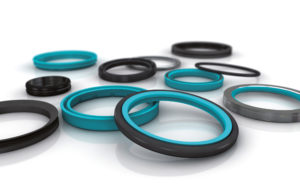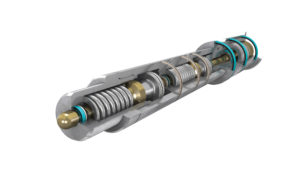 Bashar Kaswari, product development engineer at Trelleborg Sealing Systems said that there are a number of reasons for seal failure in hydraulic systems, but the most common may be a surprise to some: improper installation.
Bashar Kaswari, product development engineer at Trelleborg Sealing Systems said that there are a number of reasons for seal failure in hydraulic systems, but the most common may be a surprise to some: improper installation.
“Seals are sometimes considered a commodity item by designers and engineers—a known quantity that doesn’t appear to require much thought,” Kaswari explained. “This can lead to a lack of care when it comes to training and/or tool selection, and that causes seals to become damaged during installation or not properly seated. The following are some of the most common causes for seal failure, some less common ones, with suggestions on how to avoid all of them.”
Improper installation
Using the right tools is critical to preventing seals from being installed in the wrong direction or being damaged during installation. Some seal materials are less robust than others, meaning it doesn’t take much to damage one enough to cause unexpected leakage.
“If the cylinder design requires installing a seal in a difficult place, a specialized installation tool such as a lead-in chamfer should be used. It’s also important to ensure there are no sharp corners in the seal grooves that could damage the seal,” Kaswari added.
“Installing a seal in the wrong direction is another common cause of failure. Careful training is a potential fix, but if it’s not sufficient, manufacturers should consider changing the design so the seal cannot be installed the wrong way or using a product that can only be installed one way. This is sometimes referred to as poka-yoke, the Japanese term for a mechanism that helps equipment operators avoid mistakes.”
Kaswari emphasized that it is also important to realize that redesigned seals may need to be installed differently than current seals of a different material, even though they are fitted in the same piece of equipment.

Sealing cutaway down-hole.
Wear
“Seals wear down over time, but there are ways to prolong their life. For example, contamination is a common cause of excessive wear. The contamination may originate outside the system or be generated internally by moving gears or pumps. Although filters help prevent contamination from affecting seals, many systems are inadequately filtered. Particles small enough to penetrate the filters enter the cylinder and speed the wear of the seal.”
Kaswari said that it is important to note that some hydraulic fluids are better at keeping contaminants away from sealed areas, so if seals are breaking down faster than expected, definitely consider changing fluids.
“In addition, higher quality bearings are less prone to being deformed under load, decreasing the type of metal-to-metal contact in the system that causes contamination from particles.”
Extrusion
“This type of seal failure is more well known to designers, involving pressure levels that can potentially cause parts of a seal to break off and flow into the gaps in the hardware,” Kaswari said. “Mitigation involves using back up rings or changing from an elastomer seal to thermoplastic one. Changing the mechanisms design to make the gaps between moving parts smaller and minimizing the area a seal can extrude into, is another option.”
Compression set
Leakage at low pressure can be a sign of seals becoming less elastic, usually referred to as compression set. Kaswari said that not surprisingly, rubber and polymer seals are more prone to this phenomenon. Seals are very dependent on their elasticity at low pressure, which is why low-pressure leakage is a good indicator of an issue. Workarounds include replacing the seal, increasing preventive maintenance, and switching to a material less susceptible to compression set.
Pressure trapping
Ideally, if two seals are next to each other, they should not seal in the same direction. However, this can occur under certain conditions, causing fluid to be trapped between the seals. Unchecked, the pressure will eventually rise to a level where the fluid bursts through and causes one of the seals to fail.
“The solution is a back-pumping design that allows fluid to be pumped back into the pressurized side of the system.”
Spiral failure
“This type of issue is usually associated with O-Rings, most often when a mechanism uses long strokes that are fairly fast, often causing the seal to twist in upon itself,” Kaswari said. “Designers can alleviate this problem by switching to a polymeric material or to a different geometry, such as a square or X ring.”
Chemical incompatibility
Kaswari said that failure due to chemical incompatibility is becoming more common as users of hydraulic systems change fluids to save money, make their process more fire resistant, or make their process less harmful to the environment.
“Some designers don’t realize it’s quite often necessary to change seal types when switching fluids. Many seals, particularly elastomers, are incompatible with newer hydraulic fluids, especially fire resistant and biodegradable ones at certain temperatures.”
“Sometimes even though the base fluid remains the same, an additive causes seals to fail. The effect is not always predictable—the seal may wear out faster than expected or simply not perform as it should.
That’s why testing seal functionality every time your hydraulic fluid changes, even if the base fluid remains the same, is critical. Compatibility information is available from both seal and fluid suppliers, but testing with your own equipment at production temperatures is highly recommended.”
Knowledge improves your odds
“By now it should be clear that there are many ways for seals to fail. However, by paying particular attention to installation and testing, you can greatly improve the odds that your seals will function as expected,” Kaswari concluded.
By Joyce Laird
The post How do you avoid seal failure? appeared first on Sealing & Contamination Control Tips.
Filed Under: Sealing, Sealing & Contamination Control Tips